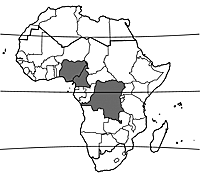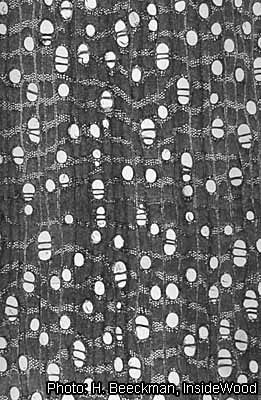Introduction |
Cynometra hankei Harms
- Protologue: Notizbl. Bot. Gart. Berlin-Dahlem, App. 21(2): 39 (1911).
- Family: Caesalpiniaceae (Leguminosae - Caesalpinioideae)
Origin and geographic distribution
Cynometra hankei occurs from south-eastern Nigeria and western Cameroon to DR Congo.
Uses
The wood, known in Cameroon as ‘nkokom’ or ‘nganga’, is used for heavy construction, bridge building, heavy flooring, joinery, railway sleepers, tool handles and sliced veneer. It is suitable for ship building, vehicle bodies, mine props, sporting goods, toys, novelties, agricultural implements, carving and turnery.
Properties
The heartwood is reddish brown, often with slightly shiny ribbon-like markings on quarter-sawn surfaces, and distinctly demarcated from the up to 3 cm wide, pale brown sapwood. The grain is straight or interlocked, texture fine.
The wood is heavy, with a density of (740–)870–980 kg/m³ at 12% moisture content. It air dries slowly with a tendency of checking and end splitting. Drying should therefore be done with care. The rates of shrinkage are high, from green to oven dry 5.1–5.7% radial and 9.9–11.0% tangential. Once dry, the wood is not stable in service.
At 12% moisture content, the modulus of rupture is 150–213 N/mm², modulus of elasticity 15,500 N/mm², compression parallel to grain 75 N/mm², cleavage 21–24 N/mm and Chalais-Meudon side hardness 7.2–10.3.
The wood saws slowly but quite well. In planing operations a 15° cutting angle is recommended to obtain a good finish, and cutting edges should be kept sharp. Pre-boring is needed for nailing and screwing, but the wood holds nails and screws well. Sanding gives smooth surfaces and the wood polishes and turns well. It is durable, being resistant to fungal, termite, Lyctus and marine borer attacks, but occasionally liable to pinhole borer attack. The heartwood is resistant to impregnation with preservatives, but the sapwood is moderately permeable. Wood dust may cause irritation to the respiratory tracts and eyes.
Some imidazole alkaloids have been isolated from the bark and seeds.
Description
- Evergreen medium-sized to large tree up to 45 m tall; bole branchless for up to 22 m, usually straight and cylindrical, up to 150 cm in diameter, with thin buttresses up to 8 m high; bark surface flaking with small scales, grey with reddish brown marks, inner bark brown, becoming reddish brown upon exposure; crown dome-shaped, with ascending branches; twigs short-hairy, with reddish lenticels.
- Leaves arranged spirally, paripinnately compound with 7–15 pairs of leaflets; stipules linear, c. 0.5 cm long, caducous; petiole and rachis together 2–10 cm long, grooved above and often slightly winged, short-hairy; leaflets opposite, sessile, oblong, 0.5–3 cm × 0.2–1 cm, rounded to slightly notched at apex, glabrous or slightly hairy below.
- Inflorescence an axillary or terminal panicle up to 12 cm long, short-hairy; bracts small.
- Flowers bisexual, nearly regular, whitish; pedicel 0.5–1.5 cm long, short-hairy, jointed near apex and persistent after shedding of flowers; sepals 4, ovate to rounded, 3–3.5 mm long, reflexed; petals 5, free, obovate to lanceolate, 3–4 mm long; stamens 10, free, 5–6 mm long, slightly unequal; ovary superior, ellipsoid, c. 2 mm long, with short stipe, hairy, 1-celled, style 2.5–3 mm long.
- Fruit a slightly obliquely oblong-obovate, flat pod 6–9 cm × 3–4 cm, with short stipe, short-pointed at apex, smooth and brown, dehiscent with 2 woody, twisting valves, 1–2-seeded.
- Seeds rounded, dark brown.
- Seedling with epigeal germination; hypocotyl 2.5–3.5 cm long, epicotyl 3–6.5 cm long; cotyledons oblong, thick and fleshy, wrinkled; first 2 leaves opposite, with many leaflets, subsequent leaves alternate.
Other botanical information
The plants described as Cynometra hankei in DR Congo differ slightly from those in Nigeria and Cameroon and may represent another, undescribed species. The leaflets are often smaller and completely glabrous, the rachis is slightly winged between the pairs of leaflets, and the pedicels are longer.
Cynometra comprises about 90 species and occurs in the tropical regions of the world. Approximately 25 species can be found in mainland tropical Africa and about 10 in Madagascar. Tropical Asia and tropical America have about 25 species each.
Cynometra mannii
The distribution area of Cynometra mannii Oliv. is largely similar to that of Cynometra hankei, occurring from south-eastern Nigeria to south-western DR Congo, often along rivers. It is a small to medium-sized tree up to 17 m tall with short, irregular bole. The reddish brown and hard wood is occasionally used, for instance to make fish traps. In Congo bark decoctions are taken to treat cough; the bark is considered purgative and emetic.
Ecology
Cynometra hankei occurs in evergreen forest up to 1000 m altitude, usually on well-drained and sandy soils. It is often found in small groups.
Management
In western Cameroon the average density of Cynometra hankei trees with a bole diameter of more than 60 cm is 0.4–0.5 per ha, and the average timber volume 2.6–3.5 m³/ha. The minimum bole diameter for harvesting is 60 cm in Cameroon. In DR Congo a tree of 35 m tall with a bole of 18 m long and a diameter of 60 cm yielded 3.5 m³ of wood.
Genetic resources
Cynometra hankei is fairly widely distributed and not uncommon, and does not seem to be threatened by genetic erosion. However, the populations in south-western Nigeria and western Cameroon could easily become endangered with ongoing deforestation.
Prospects
The hard and heavy wood and the often high buttresses of Cynometra hankei are serious drawbacks for commercialization efforts. However, the high natural durability and high resistance to abrasion of the wood offer possibilities for commercial timber production for special purposes such as heavy-duty flooring, as long as long rotation cycles are acceptable. Research is recommended on the growth rates under favourable conditions and appropriate management systems. The biosystematics of populations in Nigeria and Cameroon on the one hand and in DR Congo on the other should be studied because they may represent different species.
Major references
- Bolza, E. & Keating, W.G., 1972. African timbers: the properties, uses and characteristics of 700 species. Division of Building Research, CSIRO, Melbourne, Australia. 710 pp.
- Fouarge, J., Gérard, G. & Sacré, E., 1953. Bois du Congo. Institut National pour l’Etude Agronomique du Congo belge (INEAC), Brussels, Belgium. 424 pp.
- Fouarge, J., Sacré, E. & Mottet, A., 1950. Appropriation des bois congolais aux besoins de la métropole. Série Technique No 38. Institut National pour l’Étude Agronomique du Congo belge (INEAC), Brussels, Belgium. 17 pp.
- Takahashi, A., 1978. Compilation of data on the mechanical properties of foreign woods (part 3) Africa. Shimane University, Matsue, Japan. 248 pp.
- Vivien, J. & Faure, J.J., 1985. Arbres des forêts denses d’Afrique Centrale. Agence de Coopération Culturelle et Technique, Paris, France. 565 pp.
Other references
- Aubréville, A., 1968. Légumineuses - Caesalpinioidées (Leguminosae - Caesalpinioideae). Flore du Gabon. Volume 15. Muséum National d’Histoire Naturelle, Paris, France. 362 pp.
- Aubréville, A., 1970. Légumineuses - Césalpinioidées (Leguminosae - Caesalpinioideae). Flore du Cameroun. Volume 9. Muséum National d’Histoire Naturelle, Paris, France. 339 pp.
- Burkill, H.M., 1995. The useful plants of West Tropical Africa. 2nd Edition. Volume 3, Families J–L. Royal Botanic Gardens, Kew, Richmond, United Kingdom. 857 pp.
- Neuwinger, H.D., 2000. African traditional medicine: a dictionary of plant use and applications. Medpharm Scientific, Stuttgart, Germany. 589 pp.
- Raponda-Walker, A. & Sillans, R., 1961. Les plantes utiles du Gabon. Paul Lechevalier, Paris, France. 614 pp.
- Tailfer, Y., 1989. La forêt dense d’Afrique centrale. Identification pratique des principaux arbres. Tome 2. CTA, Wageningen, Pays Bas. pp. 465–1271.
- Waterman, P.G. & Faulkner, D.F., 1981. Imidazole alkaloids from Cynometra hankei. Phytochemistry 20(12): 2765–2767.
- Wilczek, R., Léonard, J., Hauman, L., Hoyle, A.C., Steyaert, R., Gilbert, G. & Boutique, R., 1952. Caesalpiniaceae. In: Robyns, W., Staner, P., Demaret, F., Germain, R., Gilbert, G., Hauman, L., Homès, M., Jurion, F., Lebrun, J., Vanden Abeele, M. & Boutique, R. (Editors). Flore du Congo belge et du Ruanda-Urundi. Spermatophytes. Volume 3. Institut National pour l’Étude Agronomique du Congo belge, Brussels, Belgium. pp. 234–554.
Author(s)
- R.H.M.J. Lemmens, PROTA Network Office Europe, Wageningen University, P.O. Box 341, 6700 AH Wageningen, Netherlands
Correct citation of this article
Lemmens, R.H.M.J., 2011. Cynometra hankei Harms. [Internet] Record from PROTA4U. Lemmens, R.H.M.J., Louppe, D. & Oteng-Amoako, A.A. (Editors). PROTA (Plant Resources of Tropical Africa / Ressources végétales de l’Afrique tropicale), Wageningen, Netherlands.
Accessed 31 May 2025.
- See the Prota4U database.



